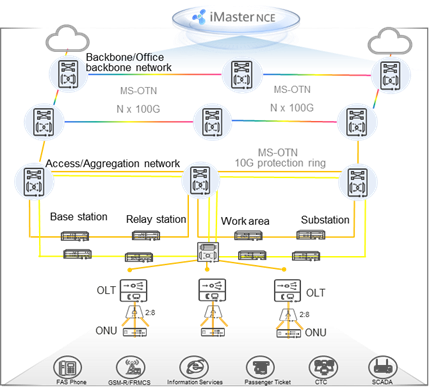As climate change is becoming a global issue, the development of railways as a green, sustainable and high-capacity transportation mode is getting more and more important. The concept of mobility as a service has also become a trend as transportation needs are changing.

Digitalisation of the rail industry is rapidly accelerating, and organisations across the sector want their key components to be digitalised and more intelligent. Building network connections based on new information and communication technologies will improve transportation efficiency and security in the railway industry.
To keep up with the current trends, Huawei is constantly investing in innovation to support this evolution. At the recent UIC World Congress on High Speed Rail in Marrakech, Huawei presented an intelligent railway all-optical integrated bearer network. This telecommunication tool is designed to provide high speed and reliable communication networks for railway operations, in response to the industry’s current needs.
‘With the acceleration of high speed railways and the development of digitalisation and intelligence, there are higher requirements for bandwidth, security, reliability, and latency’, said Wan Xifeng, Chief Architect of Huawei’s Enterprise Optical Domain, speaking at the opening ceremony of the Congress in Morocco.
Huawei’s all-optical communication network solution consists of the backbone layer, aggregation layer, and access layer. The backbone layer implements high bandwidth, physical isolation, and low latency. The aggregation layer and access layer support integrated bearing of multiple services and are compatible with GSM-R and FRMCS wireless communication technologies, ensuring smooth evolution of the train control network. In addition, the network management platform inherits the SDH O&M habits, allowing the O&M team to be reused, simplifying the O&M and single-fibre bidirectional transmission of IEEE1588 V2 high-precision clocks. The following sections describe the architecture.

The backbone network serves as the basis of the future-oriented intelligent railway network. Why do we need to build a backbone network?
The rapid development of railways accelerates transformation from lines to multi-line networks, the cloud-based smart services and bandwidth operations have been the driving force for the construction of backbone network. Lines are interconnected, backbone network possess high bandwidth and allows one-hop connection, and its resources can be used to achieve bandwidth operation.
What are Huawei’s advantages over other industry products?
- Long-haul transmission: The 400G is 25% more than the industry average.
- Higher bandwidth per fibre: the number of λs per fiber is 42% higher than the industry average.
- More bandwidth resources over a single fibre: The 800G has 25% more spectrum resources than the industry average

With the increasing demand for railway communications, the next-generation standard FRMCS continues to evolve in the future. GSM-R carried by SDH is widely deployed in the live network. Along the evolution, GSM-R and FRMCS will coexist for 5 to 10 years during the reconstruction. Therefore, the future smart railway bearer network must ensure a seamless service transmission during the evolution from GSM-R to FRMCS and provide physically isolated independent channels for different services.
For aggregation layer, Huawei’s OptiXtrans E6600 series device is recommended as it features multi-service optical transport network architecture, plus 4-in-1 high integration of PCM/SDH/PKT/OTN systems. With a unified service bearing and a simplified network, it reduces total cost of ownership and maintains consistency in operations and maintenance.
How does Huawei MS-OTN achieve smooth evolution from GSM-R to FRMCS? For example, if GSM-R and FRMCS are carried on the same device, you only need to select different tributary boards and install 2M SDH boards on the GSM-R bearer network. In FRMCS, you only need to upgrade tributary boards to ETH boards to implement smooth evolution of the bearer network. This makes evolution faster and more efficient.

The smart railway all-optical bearer network covers not only transmission solutions, but also railway stations, workshops, and trackside access networks. Compared with the traditional industrial switch solution, Huawei’s access network solution reduces the weak-current equipment room space by 80% and cabling costs by 50%, providing hard pipe isolation for different access services. Provides carrier-class protection with 99.999% reliability, and the switching time is less than 50 ms.
iMaster NCE is an autonomous network management and control system with management, control, and analysis capabilities. This tool inherits the O&M habits of SDH and supports real-time service SLA monitoring, automatic threshold-crossing warning, fibre and channel health prediction, and proactive fault warning, ensuring high-quality transmission of optical private line services. In addition, the latency map is used to evaluate the site latency and bandwidth, which helps quickly match network resources and supports precise location and quick O&M.
In all, the MS-OTN solution is the evolution of SDH which inherited SDH features, supporting multi-service access, ultra-high bandwidth, high security and reliability, smooth evolution, and easy E2E O&M, which further ensures secure railway operations and reduce investment costs.
Enabling a smarter railway communication network
The rapid increase of communication traffic brought by smart railway operation proposed higher demands for bandwidth, Huawei’s intelligent railway all-optical integrated bearer network enabling an ultra-large bandwidth, increased by more than 10 times, it not only helps the customer to save optical fibre resources, but also provides sufficient bandwidth for bandwidth operation, which is a new service growth point.
The solution provides flexible access to cloud. The optical service unit technology is used to implement one-hop direct service transmission from the device to the control centre, which has the advantage of extremely low latency and supports diversified intelligent railway service applications.
Based on the time division multiplex hard pipe technology, the MS-OTN implements end-to-end isolation and bearing of railway services such as PIS, AFC, ETCS, guaranteeing a securer and more reliable railway operation.
The multi-service optical transport network platform supports GSM-R services on the synchronous digital hierarchy plane and future railway mobile communication system services on the MPLS-TP plane, ensuring smooth service evolution and protecting customers’ investment.
Keeping up with digitalisation
Digitalisation of the rail industry is rapidly accelerating and Huawei will continue to explore innovations and practices, fully utilise its information and communication technology capabilities, and build a digital infrastructure network foundation forthe intelligent rail transportaion industry, helping steadily promote the digital transformation of railways.

















